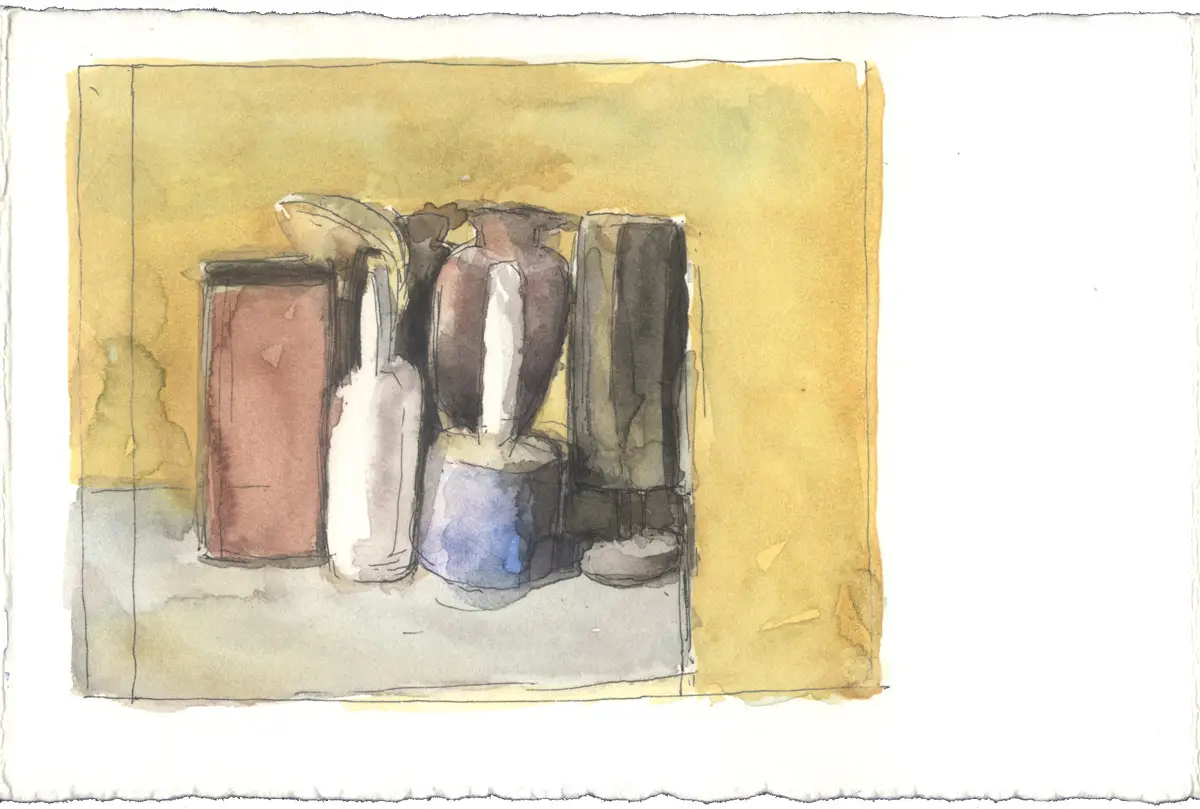
(above) Charles Ritchie, sketch after an oil painting by Giorgio Morandi, watercolor and pen and ink on Fabriano paper, one panel from an uncatalogued accordion fold drawing dated 8 August 1987, panel size 4 x 6.”
Cadence
I admire artists like Giorgio Morandi, who draw energy from diligent, sustained questioning. Morandi found a lifetime’s worth of investigation in a select group of motifs. His invention within the genres of still life and landscape relied on his ability to reduce subjects to an essence; engaging often incremental shifts in subject, lighting, palette, size, and format. The completion of each painting seemed to only rekindle a quest to find new ways to cultivate subtle variation and inflection. I am reminded of poet E.E. Cummings’ quote “Always the beautiful answer that asks the more beautiful question.”
For me, it’s easy to see how Morandi could find his limitations freeing; he woke each morning prepared to paint the what, allowing him to jump ahead to the challenges of how. Morandi’s oeuvre is filled with a cadence; a visual repetition of subjects in variation as well as the implied cadence of his own engagements. One of the most exciting images I have seen in years is from a recently published book of photographs by Gianni Berengo Gardin called Giorgio Morandi’s Studio. The book lovingly visits Morandi’s studio/quarters in exquisite black and white images. One shot features the tabletop on which Morandi arranged his still life subjects lifted to reveal the web of traced arcs and contours representing footprints of the many subjects that the artist arranged and rearranged on that table. The artist’s hand-drawn record of locations, beyond being a beautiful abstract image on its own, conveys echoes of Morandi’s cadence.
I’m attracted to other artists whose cadence is evident. On Kawara makes paintings that feature the date of the work’s execution in large block letters across his canvas; he commits himself to finishing the painting by day’s end. Other serial activities by the artist include sending postcards to acquaintances noting date, location, and the time he woke up; or telegrams stating simply ”I am still alive.” In another rigorous reflection of on existence, Roman Opalka has been executing the same painting since 1965; each canvas, called a detail, continues the linear painted sequence of numbers from 1 to an implied infinity. In a parallel meditation on time and change, he photographs himself beside the canvas at the end of each day. Or consider artist, Tehching Hsieh who executed a rigorous series of performance projects each lasting a year. These included punching a time clock every hour on the hour, living in a cage, or tying himself to another artist for that time period.
Each of the projects I have mentioned above document the passage of time and, to my mind, extend the notion of the journal. Regardless of how one leaves the imprint of one’s cadence, our endless numbered days are passing. How can we document them? Perhaps, Opalka has articulated it best; “the problem is that we are, and are about not to be.”
(above) Charles Ritchie, two page spread from Book 131 featuring sketches after oil paintings by Giorgio Morandi, watercolor, graphite, and pen and ink on Arches paper, March 2009, each page 4 x 6”.
Note: I tip my hat to several friends who have in recent months brought artists Roman Opalka and Tehching Hsieh to my attention. My associates’ insights have informed this online journal entry.